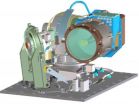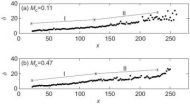Medical students may benefit from social media guidance
2014-05-22
(Press-News.org) Medical students use social media extensively, but medical schools may need to offer more guidance in potential pitfalls, according to Penn State College of Medicine researchers.
"We assessed how medical students engage with social media platforms like Facebook and found that they have a pretty sophisticated understanding of its risks and benefits," said Daniel R. George, assistant professor of humanities. He and Dr. Michael J. Green, professor of humanities, conducted two studies that report findings from a survey of 2,109 medical students nationwide.
In the first study, researchers asked students how they and their peers would and should respond to eight hypothetical scenarios involving Facebook. The scenarios focused on ethical issues including privacy, the patient-doctor relationship and relationships with peers.
In one scenario, a student revealed on Facebook that she was caring for a local weatherman. The majority of students, 55 percent, said they should address a peer who violates patient privacy on Facebook. Almost half of the students also indicated that this is what they would actually do. However, 31 percent thought their peers would not do anything to address the situation.
Another hypothetical scenario involved a patient asking a student for medical advice over Facebook. Most students, 61 percent, said that they should explain to the patient that this form of communication is not acceptable. However, 30 percent believed their peers would send a short message with the advice asked.
The researchers reported their findings in AJOB Empirical Bioethics.
Overall, the students seemed to be mindful of the potential dangers of social media use and had a good understanding of how it could be used or misused in a professional context. However, when faced with an ethical dilemma, there was a disconnect between what the students said they would do versus what they thought they should do. Though 39 percent of students said that they should tell a hypothetical peer to remove drunken pictures and foul language from Facebook, 41 percent said they would actually do nothing. Most felt their peers would probably do nothing as well.
Some students promoted strategies for integrating Facebook into future practice, such as sending appointment reminders and relaying public health information to their patient base.
In the words of one student, "If I had a professional Facebook account, (patients) could stay updated on things like schedule changes, get (appointment) reminders, join fundraisers…or stay up to date on public health type information."
"I think some patients would see it as above and beyond if a doctor messaged them to see how they were doing," wrote another. "In this day and age I think a lot of patients might actually appreciate that kind of personal contact from their doctor."
"Students seem to understand the risks of using social media like Facebook, but there is clearly a need for medical schools to help students take the proper course of action," said George.
In the second study, published in BMJ Postgraduate Medical Journal, the researchers examined what students believe about the ways residency programs use Facebook in their admission processes.
Researchers presented students with a hypothetical situation in which a residency admissions committee finds inappropriate pictures on an applicant's Facebook page. The pictures showed the applicant drinking beer and wearing a provocative Halloween costume. Researchers asked students how the admissions committee should respond.
More than 60 percent of students believed that the inappropriate pictures alone should not result in rejection from the residency program, but that the pictures should be considered along with other factors. About a third of the students thought the pictures should have no influence on the application process whatsoever. Less than three percent indicated that the pictures should be grounds for rejection.
However, previous research has found that more than half of the residency programs in the country would reject applicants based on unprofessional Facebook content, such as the inappropriate pictures in the scenario.
"Although most students feel that social media profiles shouldn't affect admission, the reality is that many admissions committees are screening them," said George. "This is another example of how medical schools have an obligation to help educate students to minimize risk."INFORMATION:
Other researchers were Anita Navarro and Kelly Stazyk, Association of American Medical Colleges; and Melissa Clark, Warren Alpert Medical School of Brown University.
Penn State College of Medicine in partnership with the Association of American Medical Colleges (AAMC) designed the survey.
ELSE PRESS RELEASES FROM THIS DATE:
Screening for autism: There's an app for that
2014-05-22
DURHAM, N.C. -- Most schools across the United States provide simple vision tests to their students--not to prescribe glasses, but to identify potential problems and recommend a trip to the optometrist. Researchers are now on the cusp of providing the same kind of service for autism.
Researchers at Duke University have developed software that tracks and records infants' activity during videotaped autism screening tests. Their results show that the program is as good at spotting behavioral markers of autism as experts giving the test themselves, and better than non-expert ...
How the gut feeling shapes fear
2014-05-22
An unlit, deserted car park at night, footsteps in the gloom. The heart beats faster and the stomach ties itself in knots. We often feel threatening situations in our stomachs. While the brain has long been viewed as the centre of all emotions, researchers are increasingly trying to get to the bottom of this proverbial gut instinct.
It is not only the brain that controls processes in our abdominal cavity; our stomach also sends signals back to the brain. At the heart of this dialogue between the brain and abdomen is the vagus nerve, which transmits signals in both directions ...
Radiofrequency ablation and complete endoscopic resection equally effective for dysplastic Barrett's esophagus
2014-05-22
DOWNERS GROVE, Ill. – May 21, 2014 – According to a new systematic review article, radiofrequency ablation and complete endoscopic resection are equally effective in the short-term treatment of dysplastic Barrett's esophagus, but adverse event rates are higher with complete endoscopic resection. The article comparing the two treatments appears in the May issue of GIE: Gastrointestinal Endoscopy, the monthly peer-reviewed scientific journal of the American Society for Gastrointestinal Endoscopy (ASGE).
Barrett's esophagus is a condition in which the lining of the esophagus ...
Molecule acts as umpire to make tough life-or-death calls
2014-05-22
(MEMPHIS, Tenn. – May 20, 2014) Researchers have demonstrated that an enzyme required for animal survival after birth functions like an umpire, making the tough calls required for a balanced response to signals that determine if cells live or die. St. Jude Children's Research Hospital scientists led the study, which was published online and appears in the May 22 edition of the scientific journal Cell.
The work involved the enzyme receptor-interacting protein kinase 1 (RIPK1). While RIPK1 is known to be involved in many vital cell processes, this study shows that its pivotal ...
Aggressive behavior observed after alcohol-related priming
2014-05-22
May 22, 2014-- Researchers from California State University, Long Beach, the University of Kent and the University of Missouri collaborated on a study to test whether briefly exposing participants to alcohol-related terms increases aggressive behavior. It has been well documented by previous research that the consumption of alcohol is directly linked to an increase in aggression and other behavioral extremes. But can simply seeing alcohol-related words have a similar effect on aggressive behavior?
Designing the experiment
The study, published in the journal Personality ...
First broadband wireless connection ... to the moon?!
2014-05-22
WASHINGTON, May 22, 2014—If future generations were to live and work on the moon or on a distant asteroid, they would probably want a broadband connection to communicate with home bases back on Earth. They may even want to watch their favorite Earth-based TV show. That may now be possible thanks to a team of researchers from the Massachusetts Institute of Technology's (MIT) Lincoln Laboratory who, working with NASA last fall, demonstrated for the first time that a data communication technology exists that can provide space dwellers with the connectivity we all enjoy here ...
On quantification of the growth of compressible mixing layer
2014-05-22
CML has been a research topic for more than five decades, due to its wide applications in propulsion design. Mixing in CML is controlled by the compressibility effects of velocity and density variations over the mixing layer, and quantified by the growth rate of CML. However, the lack of understanding of various definitions of mixing thicknesses has yielded scatter in analyzing experimental data. Prof. SHE ZhenSu and his colleagues at the State Key Laboratory for Turbulence and Complex Systems, Peking University investigated the growth of compressible mixing layer by introducing ...
Nanoshell-emitters hybrid nanoobject was proposed as promising 2-photon fluorescence probe
2014-05-22
Two-photon excitation fluorescence is growing in popularity in the bioimaging field but is limited by fluorophores' extremely low two-photon absorption cross-section. The researcher Dr. Guowei Lu and co-workers from State Key Laboratory for Mesoscopic Physics, Department of Physics, Peking University, are endeavoring to develop efficient fluorescent probes with improved two-photon fluorescence (TPF) performance. They theoretically present a promising bright probe using gold nanoshell to improve the TPF performances of fluorescent emitters. Their work, entitled "Plasmonic-Enhanced ...
Stanford research shows importance of European farmers adapting to climate change
2014-05-22
A new Stanford study finds that due to an average 3.5 degrees Fahrenheit of warming expected by 2040, yields of wheat and barley across Europe will drop more than 20 percent.
New Stanford research reveals that farmers in Europe will see crop yields affected as global temperatures rise, but that adaptation can help slow the decline for some crops.
For corn, the anticipated loss is roughly 10 percent, the research shows. Farmers of these crops have already seen yield growth slow down since 1980 as temperatures have risen, though other policy and economic factors have ...
Symbiosis or capitalism? A new view of forest fungi
2014-05-22
The so-called symbiotic relationship between trees and the fungus that grow on their roots may actually work more like a capitalist market relationship between buyers and sellers, according to the new study published in the journal New Phytologist.
Recent experiments in the forests of Sweden had brought into a question a long-held theory of biology: that the fungi or mycorrhizae that grow on tree roots work with trees in a symbiotic relationship that is beneficial for both the fungi and the trees, providing needed nutrients to both parties. These fungi, including many ...



